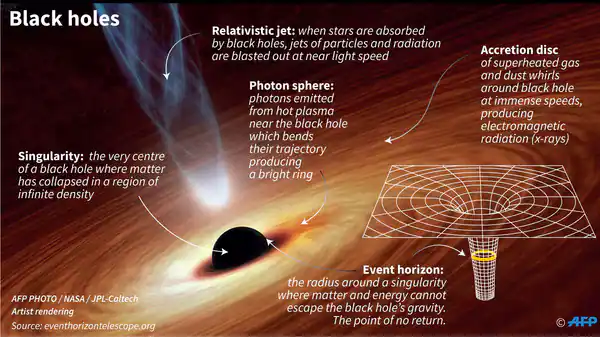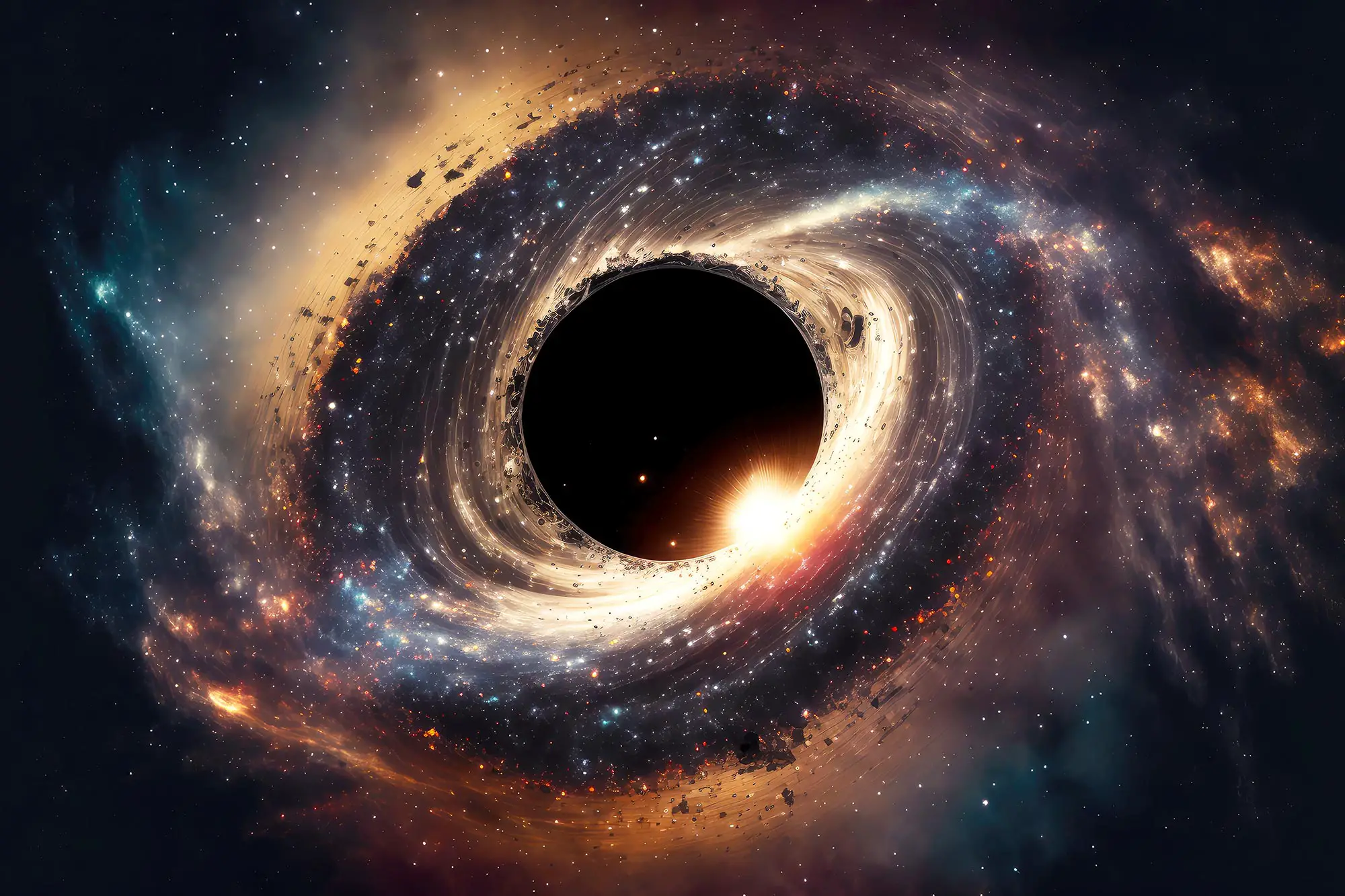A black hole is a region of spacetime exhibiting gravitational acceleration so strong that nothing—no particles or even electromagnetic radiation such as light—can escape from it. The theory of general relativity predicts that a sufficiently compact mass can deform spacetime to form a black hole. The boundary of the region from which no escape is possible is called the event horizon.
Black holes are formed from the remnants of massive stars after they undergo gravitational collapse. If a star has a mass above a certain threshold, roughly around three times the mass of the Sun, it can undergo a supernova explosion, and the remaining core may collapse under gravity to form a black hole.TYPES OF BLACK HOLES,CATEGORIZED BASED ON THEIR MASS :-
- tellar-Mass Black Holes: Formed by the gravitational collapse of massive stars, these black holes typically have a mass ranging from a few times that of the Sun to around 20 times the solar mass.
- Intermediate Black Holes: With masses between 100 and 1000 times that of the Sun, the existence of intermediate black holes is still somewhat speculative, and their formation is not yet well-understood.
- Supermassive Black Holes: Found at the centers of most galaxies, including our Milky Way, these black holes have masses ranging from hundreds of thousands to billions of times that of the Sun. Their origin is still a topic of research, and they likely play a crucial role in the evolution of galaxies.
Black holes do not emit light, making them challenging to observe directly. However, scientists can infer their presence by studying the gravitational effects they have on nearby matter or by detecting other phenomena associated with black hole interactions, such as X-ray emissions from accretion disks formed by surrounding matter spiraling into the black hole
HOW IS BLACK HOLE FORMED :-
Black holes are formed through the gravitational collapse of massive stars. The process begins with the life cycle of a massive star, typically one with a mass several times that of the Sun.
- Birth of Massive Stars: Massive stars are born from the gravitational collapse of dense regions within interstellar gas and dust clouds. The core of a massive star undergoes nuclear fusion, converting hydrogen into helium and releasing a tremendous amount of energy in the form of light and heat.
- Nuclear Fusion Sustains the Star: Throughout its life, a massive star balances the force of gravity trying to collapse it with the outward pressure generated by nuclear fusion in its core. This delicate equilibrium maintains the star’s stability for millions of years.
- Exhaustion of Nuclear Fuel: As the star ages, it exhausts its nuclear fuel. Initially, it fuses lighter elements into heavier ones. However, once it reaches the stage of iron fusion, further fusion becomes energetically unfavorable. Iron fusion absorbs, rather than releases, energy, leading to a collapse of the star’s core.
- Supernova Explosion: The collapsing core triggers a catastrophic event known as a supernova. The outer layers of the star are expelled into space, creating a powerful shockwave. The core, however, undergoes further collapse.
- Formation of a Neutron Star or Black Hole: The fate of the collapsing core depends on its mass. If the core’s mass is below a certain critical value (around 2.5 to 3 times the mass of the Sun), it may form a neutron star—a highly dense remnant composed mostly of neutrons. If the mass exceeds this critical value, gravitational forces overwhelm all other forces, and the core collapses infinitely, forming a black hole.
DISCOVERY OF BLACK HOLES :-

The concept of a black hole was first theorized in the early 20th century, primarily as a solution to Einstein’s equations of general relativity. However, the term “black hole” itself was coined later.
- Theoretical Foundations (Early 20th Century):
- The idea of a gravitational collapse leading to a region where gravity is so strong that nothing can escape was theorized by physicist Karl Schwarzschild in 1916, shortly after Einstein formulated general relativity.
- However, it wasn’t initially clear how relevant or common such objects might be in the universe.
- Coining the Term “Black Hole” (1967):
- The term “black hole” was coined by physicist John Archibald Wheeler during a lecture in 1967. Before this, these objects were often referred to as “collapsars” or “frozen stars.”
- The name “black hole” captures the idea that these objects are invisible and exhibit a gravitational pull so strong that not even light can escape.
- Observational Evidence and Discoveries:
- Cygnus X-1: One of the earliest strong candidates for a black hole was Cygnus X-1, a binary star system, where an unseen compact object was observed pulling material from its companion star. This object’s mass was estimated to be well above the limit for a neutron star, suggesting a black hole. This discovery was made in the early 1970s.
- X-ray Binaries: Observations of X-ray binaries, where a compact object pulls material from a companion star, provided additional evidence for the existence of black holes. These systems exhibit characteristics consistent with the presence of a black hole.
- Gravitational Wave Detection (2015):
- The first direct detection of gravitational waves, predicted by Einstein’s theory of general relativity, was announced in 2016. This observation was made by the Laser Interferometer Gravitational-Wave Observatory (LIGO) and the Virgo interferometer. The detected gravitational waves were generated by the merger of two black holes, providing direct observational evidence of black hole collisions.
- Event Horizon Telescope (2019):
- The Event Horizon Telescope (EHT) collaboration made headlines in 2019 by capturing the first-ever image of a black hole. The image, which showed the shadow of a black hole at the center of the galaxy M87, marked a significant milestone in observational astronomy.
These discoveries and observations have collectively strengthened our understanding of black holes and provided direct evidence supporting their existence. Ongoing advancements in observational technology and theoretical models continue to enhance our knowledge of these enigmatic cosmic objects.
